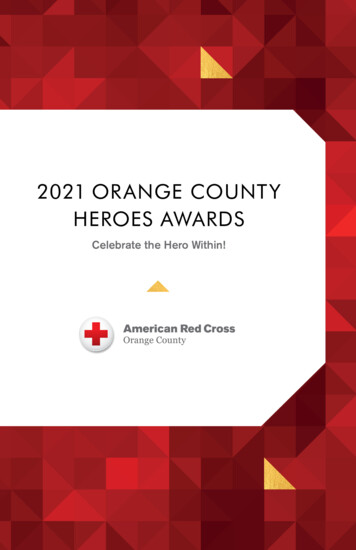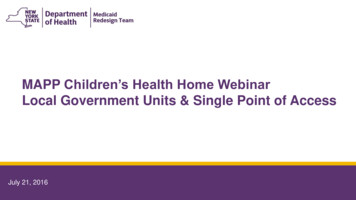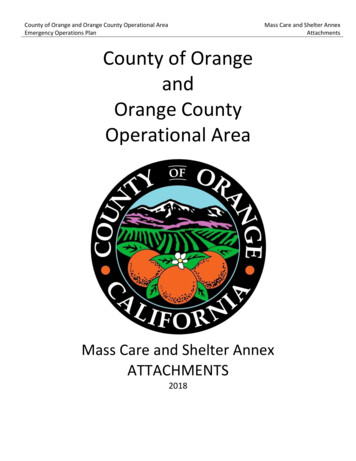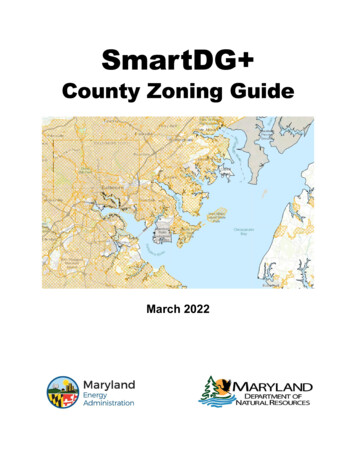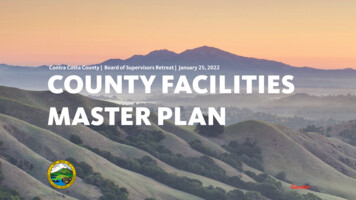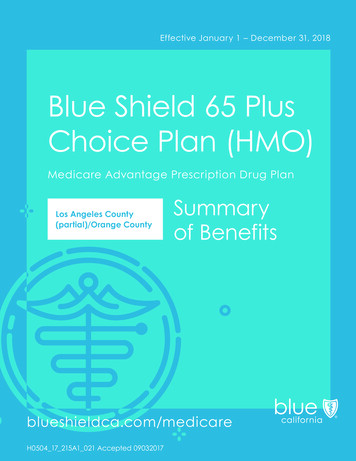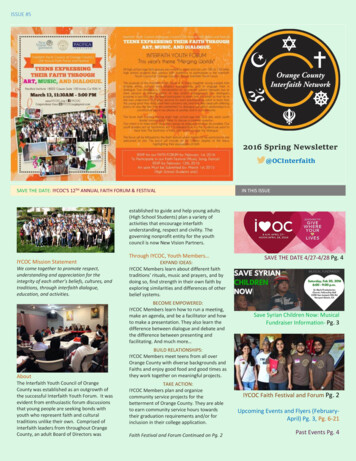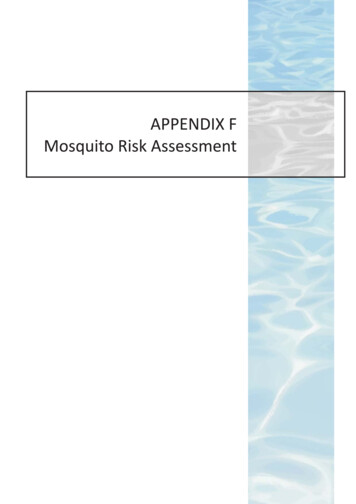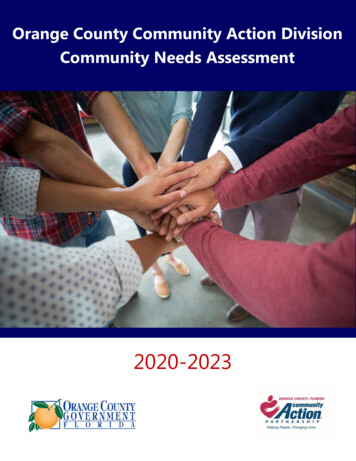
Transcription
Orange County Community Action DivisionCommunity Needs Assessment2020-2023Orange County CommunityActionPage 1 of 41
COMPREHENSIVE NEEDS ASSESSMENTTABLE OF CONTENTSTable of Contents . 2List of Tables . 3List of Figures . 3Executive Summary . 4Introduction . 5Community Action Division Profile . 5Rationale for a Comprehensive Needs Assessment . 6Root Causes and Conditions of Poverty . 7Key Sector Engagement . 8Methodology . 8Community Demographic & Statistical Profile . 10Community Action Division Service Area . 11Population of Orange County . 11Housing . 12Education and economic characteristics . 14Characteristics of Children’s Social and Physical Health Status . 16Poverty in orange county . 18Persons living at 125% of the Federal Poverty guideline . 19Health characteristics . 23Data from orange county community action clients . 25Community Assessment of Poverty Needs and Conditions . 29Community Assessment by Geographic Area Served . 30Orange County Community ActionPage 2 of 41
COMPREHENSIVE NEEDS ASSESSMENTDistressed Community Index . 30Needs and Services. 37United Way 211 Data . 37Community Input . 37Key Stakeholder Interviews . 37Strategic Plan Internal and External Analysis . 40Appendices . 41LIST OF TABLESTable 1. Census Demographic Estimates . 11Table 2. Housing and Living Characteristics . 13Table 3. Socioeconomic Characteristics . 15Table 4. Characteristics of Children’s Social and Physical Health Status . 16Table 5. Poverty Characteristics . 18Table 6. Selected Social, Economic, and Demographic Characteristics of persons below 125% FPL . 21Table 7. Health Characteristics . 24Table 8. Client Individual Characteristics. 26Table 9. Client Individual Characteristics . 27Table 10. Distressed Communities Index, 2012-2016 . 33Table 11. Distressed Communities Index, 2007-2011 . 34LIST OF FIGURESFigure 1. Community Action Community Centers. 32Orange County Community ActionPage 3 of 41
COMPREHENSIVE NEEDS ASSESSMENTEXECUTIVE SUMMARYThis Community Needs Assessment was commissioned on behalf of the Orange CountyCommunity Action Division and represents a comprehensive review of public health, publicadministration, and education data from a variety of local, state, and national data sources.This assessment is meant to inform strategic planning and the tailoring of services to address theeconomic needs of Orange County citizens, prioritizing those who live below the federal povertylevel (FPL). As a result, a variety of data sources were analyzed for this assessment including thatfrom local community organizations, key stakeholders, other county divisions, and state, andfederal sources. This assessment serves as a guide to the Community Action Board and theCommunity Action Division as they work together to strengthen existing economic self-sufficiencyprograms and services, and plan future interventions and services for disadvantaged residents.In recognizing how economic self-sufficiency is determined by social, environmental, physical, andfinancial factors, this needs assessment includes elements from each of those domains indescribing the total needs of the community on the causal pathway to self-sufficiency.As was true during the last assessment period, the Distressed Community Index reflected andconfirmed that geographic regions with community action centers had higher level of distressthan the County overall. For example, the Distressed Index Score for Orange county has reduceddramatically to 19.1, but the Holden Heights zip code Distress Score is 91.8 – the highest in thearea. While Orange County is ranked “prosperous” on the Distress Tier scale, two CommunityAction Service Centers are in areas that are considered “distressed,” and three centers are locatedin “at risk” areas.Housing remains the number one need sought by residents, and the Orange County NeedsAssessment on Housing determined that housing challenges are more prevalent among incomeconstrained residents who rent. While 55% of Orange County residents own their homes, only18% of Community Action clients own their home. The median cost of a mortgage in OrangeOrange County Community ActionPage 4 of 41
COMPREHENSIVE NEEDS ASSESSMENTCounty is 50 cheaper than the national average, but the average cost of rent is 127 higher –even though median household incomes in Orange County are over 6,000 less than the nationalaverage.Despite the challenges that persist, several services needed in the community are alreadyoccurring within the Community Action Division, or a partnership is planned for the commissionof such services. Additionally, services that were identified in the previous needs assessment (GEDand ESOL classes, computer classes, and financial literacy workshops), have been implemented inthe Division. The Family Self-Sufficiency program, the Low-Income Home Energy AssistanceProgram (LIHEAP), and the Weatherization Program (WAP) will also continue to serve thecommunity on the causal pathway to self-sufficiency.INTRODUCTIONCOMMUNITY ACTION DIVISION PROFILEThe Community Action Division (CAD) became a public agency under the Orange County Boardof County Commissioners (BCC) in 1969 and became a County division in 2001. The Divisionprovides a range of services designed to assist low-income individuals and families to acquireskills and competencies necessary to obtain employment and to achieve economic selfsufficiency. The Division’s mission is to enhance quality of life by promoting self-sufficiency andeliminating the causes and consequences of poverty; this is achieved by mobilizing and directingsocioeconomic resources, collaboration and partnership, and by providing high-quality, easilyaccessible programs and services. The Division’s vision is “to help individuals and families achieveeconomic self-sufficiency by leveraging partnerships that produce a range of culturallycompetent, accessible, high-quality services to meet the needs of a diverse community.” TheDivision is funded by a Community Services Block Grant (CSBG) and the Orange County Board ofCounty Commissioners – which serves as its governing board. In addition to the BCC, a tripartiteOrange County Community ActionPage 5 of 41
COMPREHENSIVE NEEDS ASSESSMENTboard consisting of elected public officials, private sector representatives, and representatives oflow-income populations provide oversite and accountability to the Division.The County also funds seven community service centers located strategically in low-incomeneighborhoods; each of these centers are fully operated by the Division. These centers serve as afocal point in the community and house a number of different activities and services. Each centerincludes meeting rooms and a computer lab that is open to the public. Services are provided tothe public by staff and by partner agencies. These services differ from center to center but includeyouth activities; senior activities such as exercise, sewing classes, and congregate meals; healthand community fairs including back-to-school, job, and college fairs; community gardens; afterschool food for children; and onsite programs to address substance abuse, domestic violence, andother similar challenges.Through CSBG funding, the Division operates a family self-sufficiency program consisting of casemanagement, employment counseling, and provision of tuition and financial support to assistindividuals in attending vocational education programs. There are community services workerslocated in four quadrants of the County — East Orange County, Taft, Pine Hills and Apopka. Otherareas with community centers are the Mercy Drive area, Holden Heights, and WinterGarden/Ocoee. Centers operated by other County divisions and/or community partners includeBithlo, Zellwood, Southwood, and the Raleigh Street area.RATIONALE FOR A COMPREHENSIVE NEEDS ASSESSMENTCommunity action agencies are mandated to conduct a community assessment as required bythe CSBG Act – Section 676(b) (11): “an assurance that the State will secure from each eligibleentity in the State a community action plan that includes a community-needs assessment forthe community served, which may be coordinated with community-needs assessments conductedfor other programs ”Orange County Community ActionPage 6 of 41
COMPREHENSIVE NEEDS ASSESSMENTCommunity action agencies are directed to base their plan on a complete analysis of thecommunity-wide conditions in order to address verified and urgent local needs. Consideration isgiven to the areas of greatest community need, the availability of resources, and the division’sown strengths and limitations. The subject of the assessment is not only the community’s needsbut also its resources or assets. In addition, an assessment of both of the community actionsagency’s strengths (assets) and of its organizational limitations (needs) is mandated.Additionally, as outlined in the Community Action Partnership’s Technical Assistance guide, localcontrol of Federal CSBG resources is predicated on regular comprehensive community needsassessments that take into account the breadth of community needs as well as the partners andresources available in a community to meet these needs.ROOT CAUSES AND CONDITIONS OF POVERTYThe scientific literature identifies the root causes of poverty as a varied combination of personaland systemic factors. These factors including individual choices, community conditions, thesystematic oppression and exploitation of women and minority groups, and political andOrange County Community ActionPage 7 of 41
COMPREHENSIVE NEEDS ASSESSMENTeconomic structures. While Orange County Government and many municipalities around theUnited States have established programs and services to mediate and eliminate the causes andconsequences of poverty, there still remains much work to do. The National Academy of Sciencesdefines poverty as economic deprivation: a lack of resources needed to obtain basic goods andservices. In Orange County, Florida, the living conditions of individuals with low resources putthem at risk biologically, psychologically, and socially. Resources include access to not onlyfinancial capital, but also social, health, and human capital. Community sustainability is achievedthrough individual, organizational, and community-level action, as well as policy changes.KEY SECTOR ENGAGEMENTPartners from 1) private, 2) non-profit, 3) faith based, 4) education, and 5) community sectorsprovide an array of services to assist the Division in achieving its performance indicators, whichare linked to national goals. The Division currently has over 100 formal and informal partners whoprovide a variety of services. Some of these partners occupy space at the community centers, andsome provide services through periodic onsite visits. Working closely with community partners isa great way to leverage funding and bring services into the community that would otherwise notexist. Working with partners also increases the diversity of activities and services available, andcreates strong bonds and a sense of ownership within the local community.METHODOLOGYThe Division utilized the (1) Technical Assistance Guide developed by the Community ActionPartnership, (2) the Community Health Needs Assessment Guide published by CommunityCommons, and (3) the University of Wisconsin Population Health Institute’s County HealthRankings Methodology to inform its needs assessment process. Several data sources werereferenced in the aforementioned guides to obtain comprehensive data. The comprehensiveassessment of community needs and resources as well as agency data informs the Divisionstrategic planning process and the annual Community Action Plan. This assessment is also thefirst step in the Results Oriented Management and Accountability (ROMA) Cycle.Orange County Community ActionPage 8 of 41
COMPREHENSIVE NEEDS ASSESSMENTThe Comprehensive Needs Assessment (CNA) serves several purposes for community actionagencies. First, the assessment offers a focus on local conditions, analyzing the economicopportunities and barriers for all residents who are at risk of remaining or becoming economicallyinsecure. CNAs identify existing and potential resources that inform opportunities forcollaboration and service delivery. Additionally, the CNA prepares the community action agency’sleadership to plan a multi-year strategy by identifying and prioritizing unmet community needs.The assessment and strategic planning processes require thinking about needs and resources ina more comprehensive framework. The assessment equips community action leaders to adopt abroad vision of the community’s future and to plan the Division’s role in leading change. Thisprocess includes using data to:1. Understand the depth and breadth of emerging and ongoing needs of economicallyinsecure residents in the community2. Choose the role the organization will play in meeting some of those needs3. Identify economic resources, social resources, and partnership opportunities in thecommunity that can help meet the needs4. Identify significant public policy issues5. Educate community residents and leaders about the identified needs and provide inputon policies and strategies6. Explain to the community the rationale behind decisions to prioritize needs and allocateresourcesThis CNA covers fiscal years 2020-2023 for Community Action in Orange County, Florida. Thisassessment consists of information from several sources. Demographics and information on keyindicators in the community were obtained primarily from Community Commons, a referenceresource from the national Community Action Partnership. The Distressed Communities IndexOrange County Community ActionPage 9 of 41
COMPREHENSIVE NEEDS ASSESSMENTproduced by the Economic Innovation Group was also utilized, along with the U.S. Census Bureau's2017 American Community Survey Five-Year Estimates (2018 data will not become until after thisreport is due). The Distressed Communities Index provides data on economic indicators relatingto poverty and community distress by zip code, while the Community Commons data covers theCounty as a whole. In addition, several sources of local information were used. Data from Heartof Florida United Way 211 was used to help determine local community needs, and the needsassessment conducted by the Housing and Community Development Division of Orange Countywas utilized to determine housing needs in the county.Direct inquiry was incorporated in several ways. A survey was conducted through interviews withkey informants in the community including the following sectors: community-basedorganizations, faith-based organizations, private sector, public sector, and educational institutions(See attached survey in the appendices). The department's Head Start Division also completed aCommunity Assessment, which was referenced in completing this report. Finally, information onclients was directly obtained via the case management software that the Division utilizes to trackall CSBG and LIHEAP services delivered.COMMUNITY DEMOGRAPHIC & STATISTICAL PROFILEA profile of the County was obtained through the CNA tool available through the NationalCommunity Action Partnership. Data for the reports originated through a partnership withCommunity Commons. Data indicators included several socioeconomic and sociodemographiccharacteristics including data on age, gender, race, poverty, housing, food security, violent crime,nativity and citizenship, and certain indicators of health. Data included in this assessment are alsostratified by income (the general county versus those who income qualify for our services), centerlocation, and client status (Division client versus non-clients).Orange County Community ActionPage 10 of 41
COMPREHENSIVE NEEDS ASSESSMENTCOMMUNITY ACTION DIVISION SERVICE AREAPOPULATION OF ORANGE COUNTYAccording to the U.S. Census Bureau’s 2018 estimate, the total population of Orange County,Florida is 1,380,645. This is over 180,000 more residents than our last needs assessment estimatein 2014, and just over 230,000 more residents since the 2010 Census. Since that 2010 Census,while the United States population is estimated to have grown 6%, and the State of Florida hasgrown 13%, the population of Orange County is estimated to have grown over 20%.Similar to the United States and the State of Florida, Orange County is about half male and halffemale. At present, there is no widely accepted estimate of residents who belong to a sexual andgender minority available on Orange County, the State of Florida, and the United States. As such,the data in this assessment are on biological sex only and not gender.Orange County is slightly more racially and ethnically diverse than the State of Florida and theUnited States, although about the same number of Orange County Residents are foreign born asFlorida residents. Proportionally, there are more veterans living in Orange County than in Floridaor the United States. Table 1 contains the demographic characteristics in this section for OrangeCounty, the State of Florida, and the United States.Table 1. Census Demographic EstimatesDataPopulation density per sq. mileOrange CountyFloridaUnited States1,268.5350.687.4Population Estimates*2018 population estimate1,380,64521,299,325327,167,4342010 population estimate1,145,95418,804,580308,758,1055.46.1Age and Sex PercentPersons under 5Orange County Community Action6.1Page 11 of 41
COMPREHENSIVE NEEDS ASSESSMENTDataOrange CountyFloridaUnited StatesPersons aged 0-1722.219.922.4Persons aged 65 11.920.516.0Female persons50.951.150.8Race and Hispanic Origin PercentWhite68.177.376.5Black or African-American22.716.913.4American Indian or Alaska Native0.60.51.3Asian5.73.05.9Native Hawaiian or other Pacific0.20.10.2Two or more races2.72.22.7Hispanic or 9,219IslanderSelected Population CharacteristicsForeign born persons (%)VeteransData are from the 2013-2017 American Community Survey 5 year estimate unless otherwise stated*Data are 2018 Census population estimatesHOUSINGJust over half of the houses in Orange County are occupied by persons who own their property;this is less than the averages for Florida and the United States. The median value of these owneroccupied units is 192,400 – similar to the United States, and almost 14,000 more than themedian home value in the State of Florida. On average, each household in Orange County isoccupied by 2-3 people. This is the same for the State of Florida and the United States.Orange County Community ActionPage 12 of 41
COMPREHENSIVE NEEDS ASSESSMENTHousing remains the number one need sought by residents, and the Orange County NeedsAssessment on Housing determined that housing challenges are more prevalent among incomeconstrained residents who rent. While 55% of Orange County residents own their homes, only18% of Community Action clients own their home. The median cost of a mortgage in OrangeCounty is 50 cheaper than the national average, but the average cost of rent is 127 higher –even though median household incomes in Orange County are over 6,000 less than the nationalaverage. Approximately 40% of Orange County residents spend more than 30% of their incomehousing.Over 90% of Orange County residents report having a computer at home –more than the stateand national averages- but 83% report having a broadband internet connection (still higher thanthe state and national averages). Over 35% of Orange County residents over the age of 5 speak alanguage other than English at home – 7% more than in Florida and 14% more than the UnitedStates. Housing and living characteristics for Orange County, the State of Florida, and the UnitedStates are detailed in Table 2, and the Orange County Housing and Community DevelopmentDivision’s comprehensive housing needs assessment is contained in the appendix section of thisdocument.Table 2. Housing and Living CharacteristicsDataOrange CountyFloridaUnited States544,4179,547,305138,537,07854.564.863.8 192,400 178,700 193,500Median mortgage costs 1,465 1,432 1,515Median rent costs 1,109 1,077 98239.736.1-Housing CharacteristicsHousing units (2018)Owner-occupied units (%)Median value of owner-occupied unitsPercent of people who spend morethan 30% of their income on housingOrange County Community ActionPage 13 of 41
COMPREHENSIVE NEEDS ASSESSMENTDataOrange CountyFloridaUnited States2.82.62.635.328.721.3Families with children under 18 (%)33.227.3-Percentage of overcrowded housing4.43.7-40.136.7-Living ArrangementsPersons per householdLiving in the same house 1 yearLanguage other than English spokenat home (%)unitsPercentage of housing with one ormore substandard conditionsComputer and Internet Use PercentHouseholds with a computer91.888.187.2Households with broadband internet83.378.678.1EDUCATION AND ECONOMIC CHARACTERISTICSMore Orange County residents over the age of 25 have a high school diploma and a collegedegree than persons in Florida or the United States. The on-time graduation rate in OrangeCounty is more than 10% higher than in the State of Florida, and 4th graders in Orange Countyperform just as well as the children in the State on reading proficiency exams. Nonetheless, thesections to follow will detail that these positive outcomes do not persist among those who live inpoverty. Table 3 details education and economic characteristics of Orange County residents.Orange County Community ActionPage 14 of 41
COMPREHENSIVE NEEDS ASSESSMENTTable 3. Socioeconomic CharacteristicsDataOrange CountyFloridaUnited StatesEducation Characteristics PercentPersons over 25 with a high school diploma88.287.687.3Persons over 25 with an associate’s degree43.738.2-Persons over 25 with a bachelor’s degree 4.158.23.13.33.7Mean travel time to work (mins)27.627.026.4Percent of the population using public transit to2.72-higherOn-time graduation ratePercentage of 4th graders who score “notproficient” or worse in readingNumber of Head Start ProgramsHead Start programs per 10,000 childrenSelected Economic CharacteristicsPercent of persons aged 16 in the civilian laborforcePercent of women aged 16 in the civilian laborforce*Unemployment rate (%)Transportationcommute to workBusiness CharacteristicsNumber of women owner firms52,067807,8179,878,397Number of minority-owned businesses (2012)63,938926,1127,952,386*Bureau of Labor Statistics 2019 estimateOrange County Community ActionPage 15 of 41
COMPREHENSIVE NEEDS ASSESSMENTCHARACTERISTICS OF CHILDREN’S SOCIAL AND PHYSICAL HEALTH STATUSAs the Community Action Division’s Family Self-Sufficiency Program case manages the entirehousehold, it is important to also acknowledge that many of our families include children. Whilechildren do not qualify as service recepients independent of their parents, we recognize thatpersons in poverty who have children face unique challenges. Children who are raised in povertyare also more likely to become adults living in poverty. Additionally, parents who have childrenwith special needs additional barriers, and this is especially true for parents with low-income. Asa result, the complete Head Start Division’s needs assessment is attached to this document in anappendix, and key educational, economic, and behavioral data on children are provided in Table4.The Annie E. Casey Foundation also provides a data center on key childhood outcomes. TheFlorida KIDS COUNT promotes the health and well-being of children and families by providingdata driven knowledge and consultation services focusing on data sources, policy research,education, and community engagement. The following data are from the Florida KIDS COUNTdata book.Table 4. Characteristics of Children’s Social and Physical Health StatusDataOrange CountyFloridaPopulation Under 18AgesPopulation in ,03351,370Children Under 18 in 8765,440Orange County Community ActionPage 16 of 41
COMPREHENSIVE NEEDS ASSESSMENTDataOrange CountyFloridaEducation IndicatorsStudents eligible for free or reduced lunch#%#%127,87164.91,637,78758.7Disciplinary ActionsIn school suspensions10,849198,882Out of school suspensions13,288172,982Placement in alternate education8917,182School dropouts32629,060Explanation of data:Students eligible for free or
COMPREHENSIVE NEEDS ASSESSMENT . Orange County Community Action Page 8 of 41 economic structures. While Orange County Government and many municipalities around the . United States have established programs and services to mediate and eliminate the causes and consequences of poverty, there still remains much work to do.
